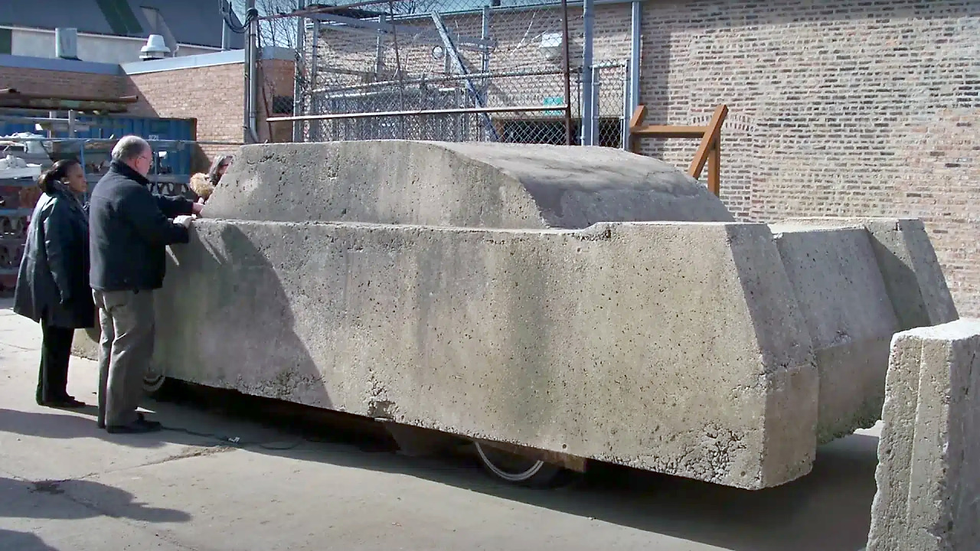1972 Mohs Safarikar
- Story Cars

- Sep 26, 2022
- 3 min read
As in the case of the Mohs Opera Sedan, the International Harvester SUV served as the basis for this phaeton, from which the frame, engine, and all-wheel drive transmission were borrowed. The SafariKar was introduced in 1972. Built on an International Harvester chassis, the SafariKars featured an aluminum body. The exterior is upholstered in Naugahyde (vinyl) stretched over foam padding. Doors for the vehicle opened outward from the body on four linear rods, again for side impact protection.
The vehicle has a retractable hard top system and a fold-down bed in the rear. Options for the SafariKar included a television, four-wheel drive, two-way radio, and "butane furnace." Only three were produced, probably all in 1972, since an early Mohs publicity photograph shows all three in various stages of assembly. "Production" of the Safari Kar was listed in several publications as late as 1979, although only the original three were built.
The bodywork was a completely original design by Bruce Moss. It was made entirely of aluminum, but the most exciting thing was its coating; it was not just polished aluminum or banal paint; the entire body was covered with vinyl, resembling leather in its structure.
The doors, which were moved sideways from the body with the help of hydraulics, also looked unusual. The convertible top was rigid and had an electric folding drive. All-wheel drive and a TV were standard for the car. Even though the car was supposed to operate in a hot climate, there was a gas heater on board that ran on butane.
Everything else could be installed at the customer's request, and although the car seems completely insane outwardly, it was released in small series. There were as many as three customers who ordered a car in 1972.
Mohs' second automotive creation was an on/off-road vehicle that entered the market in 1972 and was named the Safarikar. As with the original Opera Sedan, big and luxurious was the theme in the Safarikar. The dual-cowl phaeton featured a retractable convertible top, rear seats converted into beds and an exterior covered in padded Naugahyde. According to the sales flyer, this covering "is not only quiet in the extreme but low in maintenance since there is no paint on the car's exterior. You merely wet, wipe and dry for cleaning. No waxing. No polishing." This car had doors on each side of the vehicle, but they weren't hinged. Instead, they slid in and out on linear shafts. The Safarikar featured a 392 cubic inch V8 engine and sold for $14,500.
While the Mohs cars were big and over-the-top, the sales literature was anything but flashy and consisted of simple black & white, two-sided flyers. These flyers included photographs and a list of equipment and features. I think the sales literature for this car should have been highly interactive with paper models that had opening doors and more illustrations about the swing and sway seats.
Mohs' patented swing sway seats featured in the sales flyers for both cars, which "compensate for centrifugal force in turns and pivot into the horizontal in the event of a frontal collision." In brief, they kept the passenger centered in their seat with no side-to-side sliding. Literature also brags that Mohs "shares no components or designs philosophy with any other car" and may have stretched the truth a bit when it stated that owners would see "minimum depreciation" in their investment.
While not considered sales literature, the AACA Library owns a collection of correspondence between Bruch Mohs and several automotive manufacturers, designers, and government agencies. The first letter comes from legendary designer Gordon Buehrig who bluntly wrote to Mohs, "I do not care for your design of a new car…I suggest you check the opinions of several people before going ahead with your present design."
In other correspondence, readers can learn that Mohs had several meetings with Ford Motor Company regarding using his seats in Ford products. We can also see his passion for safety in communications with the Department of Transportation, which, at one time, considered Mohs for an appointment with a newly formed Experimental Safety Program.
Mohs cars may have been big on style, power, and appointments, but their sales literature, while informative, lacked the flair, originality, and attitude of the ostentatious vehicles.
Source: Hemmings Classic Car #119, August 2014 via cargeekjournal.com
Images: Alden Jewell Collection; cargeekjournal.com




































Comments